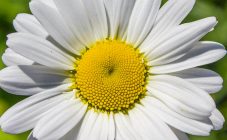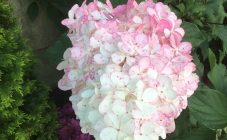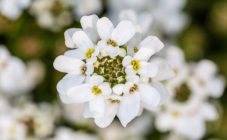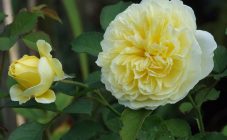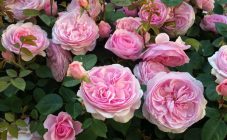Shrub aster is a decoration of any garden and the pride of the owner. It is a branched bush, which reaches a height of 90 cm, with dark green branched stems and large oval toothed leaves. The upper part of the leaf is rough, the lower one is glossy.
Popular varieties of bush asters
The most popular varieties for both beginner and experienced gardeners are:
- Shrub aster Wood’spurple is perennial. Shrub up to 50 cm high with abundant inflorescences, which consist of a large number of small yellow flowers with a pinkish-purple border. Flowering begins in mid-spring, by the end of summer, the flowers change color. For normal development and abundant flowering, the plant needs a well-lit place, sheltered from drafts, fertile soil, regular watering and feeding. Differs in good frost resistance and high immunity to pests (spider mites, scoops, meadow bugs, slugs and snails) and diseases (blackleg fungus, fusarium).
- Kristina is a low-growing shrub with a late flowering period (early October - before the first frost). Small pink-white flowers with double tongues. The variety is resistant to pests (scoop, spider mite, meadow bugs, slugs) and frost. With a lack of soil fertility, organic and mineral fertilizers, the flowers become smaller, the leaves turn pale and fall off.
- Schneekissen is a low spherical bush up to 25 cm high and up to 60 cm in diameter. It blooms in late September - early October with delicate white flowers with a yellow core. The variety has a weak immunity to diseases, medium frost resistance. In severe frosts, it requires shelter. Recommended to grow in the southern and middle regions of Russia. For abundant flowering, fertile loose soil and a well-lit area are needed.
- Aster Blue Bird ("Blue Bird") - a short bush with a large number of inflorescences, consisting of small flowers. The semi-double blue flower gradually acquires a lilac color. Proper care and regular watering will promote long and abundant flowering.
- Bush aster Venus Dwarf is a low plant (up to 20 cm). Ideal for growing outdoors (as a curb plant), balconies and hanging planters. The lilac-pink flowers bloom in September and bloom throughout the month. The variety is characterized by medium resistance to frost and disease.
- Royal Nubi is a medium-sized shrub with a height of 50-150 cm. Leaves are linear-lacent with a blunt base. Inflorescences are large, paniculate, consist of small purple flowers with purple blotches. Abundant flowering is observed when grown in warm, well-lit areas with fertile soil. Flowering begins in September and continues for 4-8 weeks. Looks spectacular on the alpine slides, in flower arrangements.
- Niobea (Niobe) - undersized perennial aster. The flowers are ligulate, white in color with a yellow core, of small diameter, collected in inflorescences. The variety is picky about soil, fertilizing and watering. The variety is slightly susceptible to diseases and pests. Due to the strong growth of roots, it requires periodic transplanting and grafting.
- Heinz Richard is a dense spherical shrub. Variety with an early flowering period (late August) lasting 4-6 weeks. The variety is not resistant to severe frosts, therefore, requires shelter for the winter. Has a stable immunity to such flower diseases as: fusarium, brown spot, fungal infection.
- Diana is a short bushy aster.Medium-sized flowers with various colors: white, raspberry, light purple, pink. Abundant bloom from September to November. The variety is frost-resistant, not whimsical to the soil. It grows well and blooms on dry and sandy loose soils.
- Dvarf Nensi (Dwarf Nancy) is a short shrub with large pale lilac flowers and ligulate petals. The variety is resistant to short-term drought and frost, but demanding to care for. In case of untimely transplantation (cuttings), the flowers become much smaller, change color.
In addition to the main varieties listed above, such varieties of shrub asters are also grown:
- ¾ Bush Astra Alice Haslam Alice Haslam is a short plant of 30-40 cm with an early flowering period (early September), lasting until the end of October. The flowers are medium-sized, pale lilac in color.
- ¾ Blue Lagune (Blue Lagoon) - frost-resistant undersized variety. The flowers are large, ranging in color from pale blue to deep blue-violet. Flowering lasts from August to October. It grows well and blooms profusely in sunny fertile areas with sufficient moisture supply.
- ¾ Astra Jenny is a short bush with branched stems of bright green color. The flowers are deep red (crimson) color. Flowering begins in June and continues for 4-8 weeks. Astra shrub undersized Jenny prefers fertile loose soils with sufficient moisture supply.
- ¾ Ledi in blue. Winter hardy undersized hybrid cultivar with delicate bright blue flowers. The buds bloom at the end of September and delight with their lush flowering until the first frost. Astra of the Lady in Blue variety is resistant to diseases and pests.
- ¾ Anneke is an absolutely unpretentious plant. Large flowers of a rich bright pink hue delight with their flowering from the end of August until the first soil frosts. During the flowering period, the Anneke aster variety requires fertilization and frequent watering.
- ¾ Peter Pan Pink is a tall plant. It blooms in late August - early September with pink buds with a bright yellow core for 4-6 weeks. The variety is picky about the composition of the soil (does not tolerate heavy loamy soils, drafts), medium frost resistance.
- ¾ Shrub aster Snowsprite is a tall plant with large white flowers. Abundant flowering begins in late August and lasts until the end of October. The variety is resistant to diseases and pests, but picky about the soil. Grows poorly and stops flowering on dry loamy soils with insufficient water supply.
- ¾ Astra medium-sized Apollo is a frost-hardy spherical bush with white buds that bloom in September. Transplanting and grafting are required every 3-4 years to prevent buds from crushing. When exposed to frost, a red coating forms on the flowers, as if enveloping the top layer of the flower.
- ¾ Starlight is a frost-hardy tall shrub that blooms with purple-pink buds at the end of August. The description of the variety says about good resistance to short-term drought and heavy rains. Starlight variety is resistant to pests and diseases.
Features of agricultural technology
A large assortment of shrub aster varieties allows you to choose a variety of any color and shape. When choosing a variety, it is important to carefully read the agrotechnological requirements of the variety for care, watering, feeding.
To combat diseases, asters are sprayed with a fungicidal solution (Fundazol, Metaldehyde, Karbofos, Phosphamine). To prevent damage to bush asters by pests, regular spraying with insecticidal solutions intended for flower crops (Aktellik, Akarin, Inta-Vir, Bi-58, Krnfidor) will help.
When preparing working solutions, it is necessary to strictly adhere to the recommended dosages and spraying rules, and observe safety measures.
Shrub aster is an excellent find for decorating a garden, which with its bright buds will cheer you up on cloudy autumn days. A perennial flower garden allows you to plant flowers every 3-4 years, which greatly facilitates caring for it. Growing rapidly, the bushes cover even the most ordinary-looking bald spots in the garden. One of the most favorite varieties is Jenny shrub aster, which gardeners are happy to grow in their backyards.
Despite the variety of varieties and subspecies of asters, shrub varieties are the most popular. They have a stable immunity to such common diseases of asters such as fusarium, blackleg fungus, brown spot, and pests such as: scoop, spider mite, plowed slugs, snails, caterpillars, meadow bugs. If a disease or pests do appear, it is urgent to take all measures to combat them.
Experienced growers recommend digging up the soil after flowering, removing and burning fallen flowers and foliage affected by the plant disease. This will prevent the fungal infection from entering the soil and further spreading it.
For a successful and long-term flowering, you need: proper planting on fertile soil, regular fertilization, regular watering, which must be increased during the budding period. The annual variety is significantly inferior in popularity among perennial varieties.


